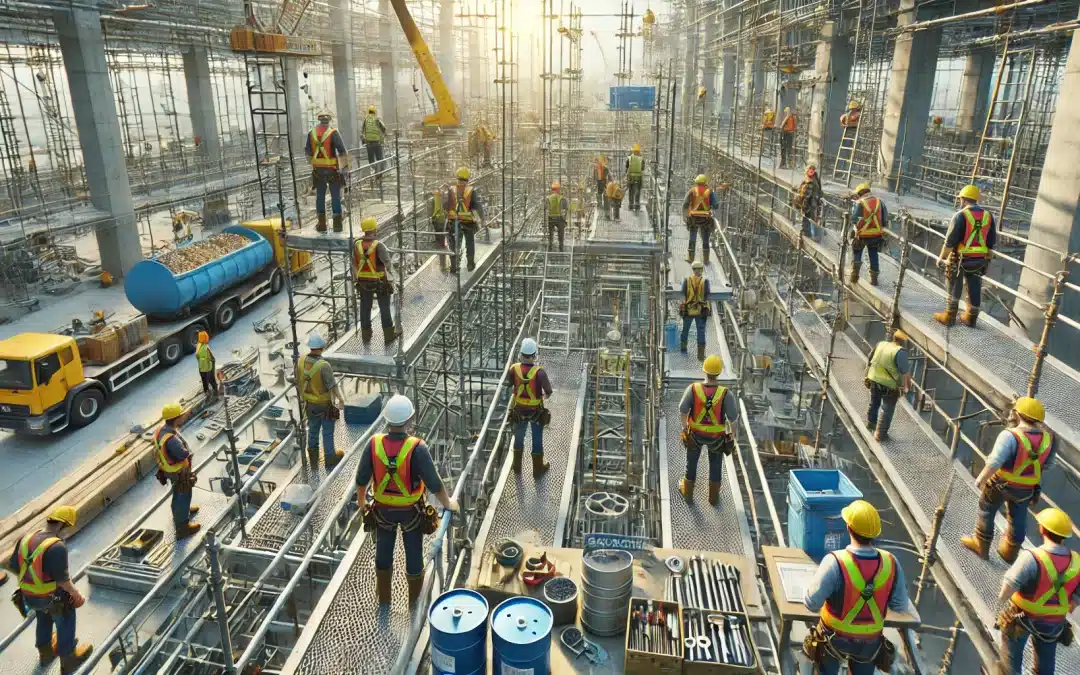When you’re working on scaffolding, you’re walking the line between getting the job done and staying safe. Scaffolding is essential for many construction projects, but it’s also one of the leading sources of accidents and injuries in the industry. Whether you’re setting up scaffolding in Ontario or anywhere else, understanding the hazards and following safety protocols is crucial. This comprehensive guide will walk you through scaffolding hazards, training requirements, tips, and the importance of fall protection.
Understanding Scaffolding Hazards
Working on scaffolding can expose you to various hazards that, if not managed properly, can lead to serious injuries or even fatalities. Knowing what to look out for is the first step in ensuring a safe work environment.
Common Scaffolding Hazards:
- Falls: The most common and dangerous hazard. Falls from scaffolding can occur due to unstable structures, lack of guardrails, or improper use of fall protection equipment.
- Collapse: Scaffolding collapse can result from overloading, improper assembly, or poor maintenance.
- Falling Objects: Tools, materials, or debris falling from scaffolding can injure workers below.
- Electrocution: Working near power lines without proper safety measures can lead to electrocution.
- Slips and Trips: Wet or slippery surfaces, cluttered platforms, and uneven footing can cause slips and trips.
Understanding these hazards helps in implementing preventive measures to ensure everyone’s safety on the job site.
Scaffold Training Requirements
In Canada, and specifically in Ontario, proper training is not just recommended—it’s legally required. Scaffold training ensures that workers understand the correct procedures for assembling, using, and dismantling scaffolds safely.
Key Training Requirements:
- Legal Knowledge: Workers must be familiar with the Occupational Health and Safety Act (OHSA) and regulations specific to scaffolding.
- Competency: Training should make workers competent in recognizing and controlling hazards, understanding load capacities, and knowing emergency procedures.
- Practical Experience: Hands-on training is crucial. Workers should practice erecting and dismantling scaffolds under supervision.
- Documentation: Employers must maintain records of training to ensure compliance with regulations.
By meeting these training requirements, workers can ensure they are prepared to handle scaffolding safely and effectively.
Top Scaffolding Safety Tips
Safety on scaffolding isn’t just about avoiding penalties; it’s about protecting lives. Here are some top tips to keep in mind:
1. Inspect Scaffolding Regularly
Before every use, inspect the scaffolding for any signs of damage, wear, or instability. Look for bent or cracked components, rust, and loose connections.
2. Follow Weight Limits
Always adhere to the manufacturer’s weight limits for scaffolding. Overloading can compromise the structure’s stability and lead to collapse.
3. Use Guardrails and Toe Boards
Install guardrails and toe boards on all open sides of the scaffold platform to prevent falls and falling objects.
4. Maintain a Clean Work Area
Keep the scaffold platform free of debris, tools, and materials to prevent trips and falls. Use tool lanyards to secure tools when working at height.
5. Ensure Proper Access
Use ladders, stair towers, or ramps to access the scaffold safely. Never climb the scaffold’s frame unless it is specifically designed for that purpose.
6. Wear Appropriate PPE
Personal Protective Equipment (PPE) such as hard hats, non-slip footwear, and fall protection gear is essential when working on scaffolding.
7. Monitor Weather Conditions
Be mindful of weather conditions. High winds, rain, or ice can make scaffolding dangerous to use. Always follow weather-related safety protocols.
Fall Protection for Scaffolding
Falls are the leading cause of injuries and fatalities in the construction industry, and scaffolding is a major contributor. Implementing effective fall protection measures is critical.
Essential Fall Protection Measures:
- Guardrails: Install guardrails on all scaffolding platforms over 3 metres high. Ensure they are secure and meet the height requirements.
- Personal Fall Arrest Systems (PFAS): When guardrails are not feasible, use PFAS, which includes a full-body harness, lanyard, and anchor point.
- Safety Nets: In some cases, safety nets can be used below the scaffold to catch workers in case of a fall.
- Training: Ensure all workers are trained in using fall protection equipment and understand the importance of fall prevention measures.
By integrating these measures, you can significantly reduce the risk of falls and protect workers from serious harm.
Scaffolding Safety in Ontario
Ontario has specific regulations and guidelines for scaffolding safety under the Occupational Health and Safety Act (OHSA). Understanding and complying with these rules is crucial for any construction project.
Ontario-Specific Guidelines:
- Regulation 213/91: This regulation outlines the requirements for scaffolding in construction projects, including the need for proper erection, inspection, and maintenance.
- Competent Person Requirement: Only a competent person—someone who is knowledgeable, experienced, and capable—should supervise the erection and dismantling of scaffolding.
- Documentation and Inspections: Regular inspections are mandatory, and records must be maintained to ensure compliance with safety standards.
- Emergency Procedures: Employers must have emergency procedures in place, including rescue plans for workers who may fall or become trapped.
Following these guidelines helps ensure that scaffolding operations in Ontario are safe and compliant with provincial laws.
Final Thoughts
Scaffolding safety is a critical aspect of construction work. Understanding the hazards, adhering to training requirements, implementing safety tips, and ensuring proper fall protection can significantly reduce the risk of accidents and injuries.
At Valley WorkSafe, we offer an online Scaffolding – Safety Training Certification designed to equip you and your team with the knowledge and skills needed to work safely on scaffolds. Our courses are highly rated, easy to access, and can often be completed in under a day. This makes them an affordable and convenient way to ensure you’re up-to-date with the latest safety practices and regulations. By investing in this certification, you can enhance safety standards, protect your workforce, and keep your projects running smoothly. Don’t wait—get certified today and build a safer tomorrow!



